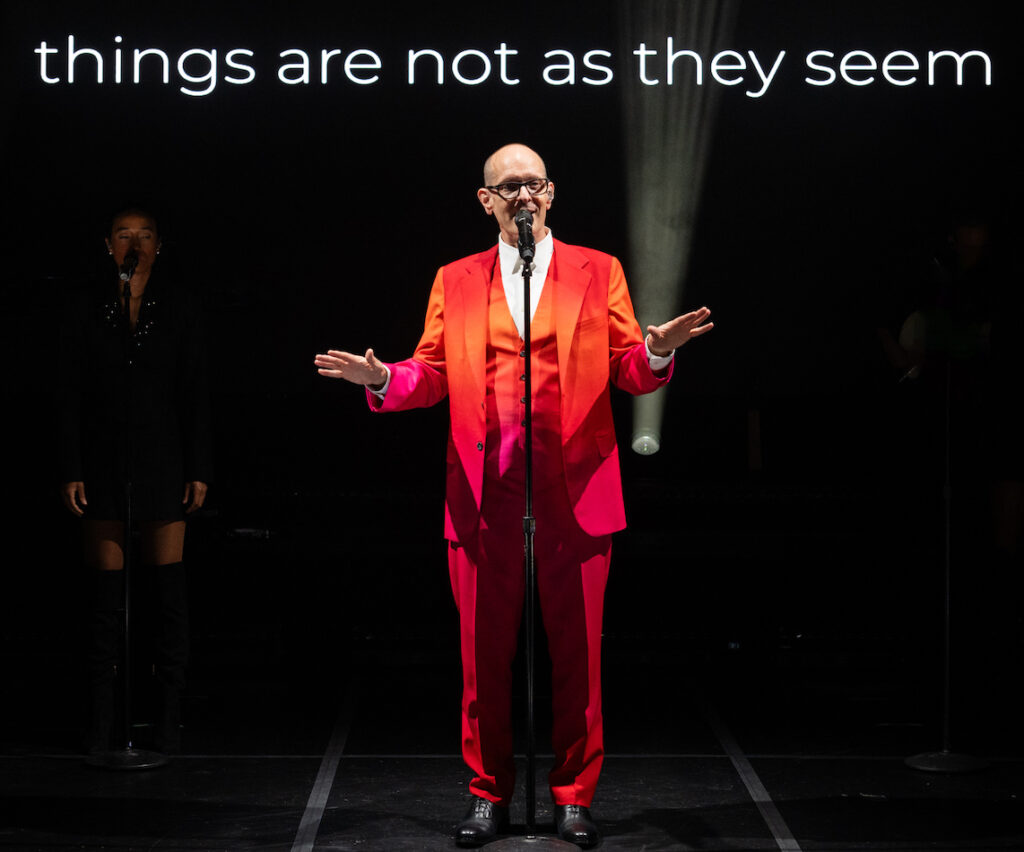By Samuel L. Leiter . . .
Patrick Olson may not be a preacher and the Alice Griffin Jewel Box Theatre may not be a church, but it’s hard to deny that Emergence, the high-powered, occasionally intriguing, but ultimately so-so, new musical that Olson created and in which he stars, comes off like a televangelical sermon-concert. Instead of gospel music, we get pop rock, its transcendent subjects based not on God but on science, and I don’t mean Christian Science.
At one point during the preview I attended, Olson came down off the stage and shook hands with audience members, making me wonder if someone was going to rise and shout, “I can walk!” And when the show ended, the entire cast, flowers in hand, waited to greet us, the way preachers might outside their church as their congregation makes its departure.
Dominating a dark, unadorned stage fitted with an upstage platform, the bespectacled, shaven-headed Olson, resembling a middle-aged high school teacher turned hipster, wears a three-piece suit that shades from orange to pink, with a tieless white shirt, buttoned to the neck (no set or costume designers are credited). He speaks or sings into a handheld mic about the nature of life and how—because of the physics lessons he imparts—nothing is what it seems to be. A former publisher of science materials, Olson is as enthused about scientific principles as any televangelist would be about Jesus; he seems, in fact, to be on a mission to share his insights by communicating them in ways even the science-challenged, like me, can comprehend.

Genial and amusing, with a solid singing voice, he serves as front man for four attractive young backup singers (Cherry Davis, Samara Brown, Miya Bass and Bella Kosai), dressed in identical black miniskirts, who join him in lots of hand choreography. The combination of Olson’s accessible braininess, the women behind him, and the heavily rhythmic songs brings to mind a blend of David Byrne and Robert Palmer.
For more conventional—if you could call it that—choreography we’re treated to a trio of extremely lithe and flexible barefooted dancers, Summer Sheldrick and Dana Liebezeit (who, in their matching leotards, could almost pass for twins), and a slender fellow named Lavy Cavaliere; stripped to the waist, he seems to have bones made of jelly. Their uncredited, well-executed routines mingle ballet and modern dance; however, intangible as they are, they serve more as window dressing than terpsichorean footnotes to what everyone’s singing about.
The only credited contributions (not even the songs and direction—all of which must be Olson’s—have names attached to them) are the lighting (by Wasted Potential and Jordan Noltner) and the LED visual design (by Futuretalk Inc., Jonathon Corbiere & Tyler Sammy, Wasted Potential, and Nick Proctor). These entities have provided not only the typical panoply of rock concert effects, with multiple beams of lights going this way and that, but a constant bombardment of projections, many of astronomical images (the earth seen from space, etc.), and nature (roiling seas, etc.) and many more of psychedelic images that amplify the atmosphere rather than explain the concepts. And for a good 90 percent of the time, even when no one’s singing, rhythmic background music performed by the four-man band (bass: Steven Styles; guitar: Nadav Hezi; drums: Jordan Coker; keys: Thomas Nickell) provides portentous support for Olson’s pronouncements.


As projected surtitles now and then highlight his ideas, Olson frequently reinforces his main theme that nothing is what it seems to be. For example, the human body, which we perceive as animate, is actually composed of trillions of inanimate chemical cells. In other words, and not to get too involved in this, we’re both alive and not alive at the same time. Then there’s our perception of where we are at any particular time, which is actually not where we think we are. There’s also the matter of time; just because we think we are in what we perceive as “now” isn’t necessarily the case.
And so on, much of it interesting; after a while, though, the steady barrage of such information (including riffs on gravity, the sudden absence of the sun, our recognition of color, how the brain perceives things, etc.)—even when spoon fed and sung about in what are obviously reductive terms—begins to wear out its welcome over the course of a nearly hour and a half running time. The music is catchy, if not especially memorable, the lyrics (sometimes indistinct) are acceptable (given their subject matter), and the performances are first-rate.
Make no mistake, this is a sermon in concert style, there’s nothing resembling a plot, the only “character” is Olson himself, who offers some autobiographical background, and the principal theme is physics. If you’re looking for a musical sermon about life, consciousness, perception, and the universe, Emergence offers the gospel truth.
Emergence. Through January 7, 2024, at the Pershing Square Signature Center/Alice Griffin Jewel Box Theatre (480 West 42nd Street, between Ninth and Tenth Avenues). www.emergenceshow.com
Photos: Russ Rowland


















